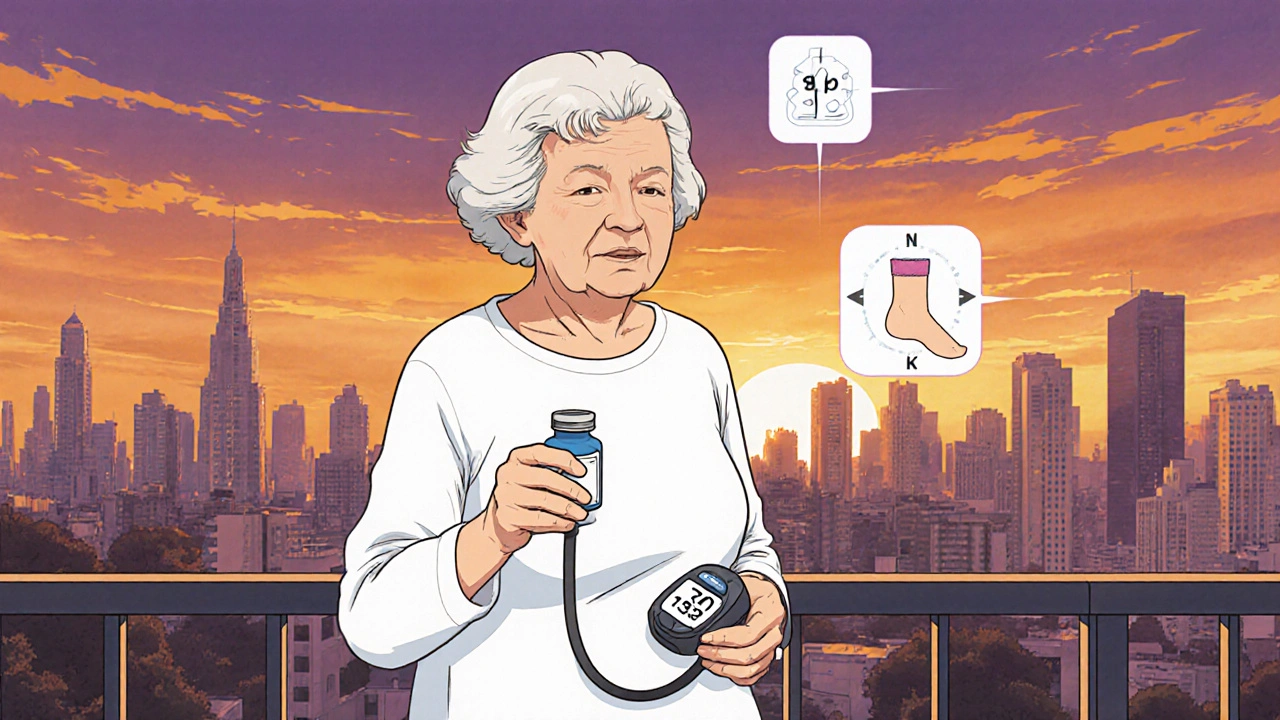Fludrocortisone Dosing Calculator for Elderly Patients
This tool calculates appropriate starting and maintenance doses of Fludrocortisone for patients aged 65 years and older based on clinical guidelines. The calculator incorporates recommendations from the article on dosing, safety, and monitoring.
Patient Information
When treating older adults with adrenal insufficiency, understanding how Fludrocortisone a synthetic mineralocorticoid used to replace lost aldosterone activity works is crucial.
What is Fludrocortisone?
Fludrocortisone mimics the hormone aldosterone, helping the kidneys retain sodium and excrete potassium. It is prescribed mainly for primary adrenal insufficiency (Addison’s disease) and secondary forms where the body cannot produce enough mineralocorticoids. By stabilising blood volume and pressure, it prevents the life‑threatening lows that can occur when the adrenal glands under‑perform.
Why Seniors Need Special Attention
People over 65 often have reduced kidney function, altered body composition, and a higher prevalence of cardiovascular disease. These factors change how fludrocortisone is processed and increase the risk of side effects such as hypertension, fluid overload, and electrolyte imbalance. Moreover, many seniors take multiple drugs that can interact with mineralocorticoid therapy.
Pharmacokinetic Changes in Older Adults
Age‑related declines in glomerular filtration rate (GFR) slow the renal clearance of sodium and potassium, amplifying the drug’s effects. Liver metabolism also slows, although Fludrocortisone is primarily eliminated unchanged via the kidneys. The net result is a higher plasma concentration for the same dose, meaning the usual adult dose may be too strong for many seniors.
Dosage Recommendations for the Elderly
Guidelines suggest starting at the lowest effective dose and titrating slowly while monitoring blood pressure, weight, and electrolytes. Below is a quick reference comparing typical adult dosing with a more cautious elderly approach.
| Patient Group | Starting Dose | Typical Maintenance Range | Key Monitoring Parameters |
|---|---|---|---|
| Adults (18‑64) | 0.05 mg once daily | 0.05‑0.2 mg per day | BP, serum Na⁺, K⁺, weight |
| Seniors (≥65) | 0.025 mg once daily | 0.025‑0.1 mg per day | BP, serum Na⁺, K⁺, GFR, edema |
Common Side Effects and Monitoring
Older patients are especially vulnerable to the following adverse events:
- Hypertension elevated blood pressure caused by excess sodium retention
- Fluid Retention weight gain or peripheral edema due to increased extracellular volume
- Hypernatremia high blood sodium levels leading to thirst, confusion, or seizures
- Hypokalemia low potassium that can cause muscle cramps, arrhythmias, or fatigue
Monitoring schedule for seniors typically includes:
- Blood pressure check at baseline, then weekly for the first month.
- Serum electrolytes (Na⁺, K⁺) at baseline, 1‑week, and monthly thereafter.
- Weight measurement at each visit; any gain >2 kg should prompt dose review.
- Renal function (creatinine, eGFR) every 3‑6 months.
Important Drug Interactions
Because Fludrocortisone acts on the same pathways as endogenous aldosterone, drugs that modify sodium or potassium balance can amplify side effects.
- ACE inhibitors lower blood pressure and potassium excretion, potentially counteracting mineralocorticoid effects - monitor K⁺ closely.
- NSAIDs can reduce renal perfusion and blunt the natriuretic response, raising fluid‑retention risk - avoid chronic use if possible.
- Potassium‑sparing diuretics e.g., spironolactone, can cause severe hyperkalemia when combined with low‑dose fludrocortisone.
Always review the full medication list, especially over‑the‑counter supplements that contain sodium or potassium.
Practical Checklist for Clinicians
- Confirm diagnosis of adrenal insufficiency (primary vs. secondary).
- Start Fludrocortisone at 0.025 mg daily for patients 65 years and older.
- Obtain baseline BP, weight, Na⁺, K⁺, creatinine, and eGFR.
- Schedule follow‑up labs at 1 week, 1 month, then every 3 months.
- Adjust dose in 0.025 mg increments based on BP and electrolyte trends.
- Educate patients to report sudden swelling, dizziness, or muscle weakness.
- Review all concurrent meds for the interactions listed above.

Case Example
Mrs. L., an 78‑year‑old with primary adrenal insufficiency, was started on 0.025 mg fludrocortisone daily. After two weeks she complained of mild ankle swelling and her BP rose to 150/90 mmHg. Labs showed Na⁺ 148 mmol/L, K⁺ 3.2 mmol/L, and eGFR 55 mL/min. The clinician reduced the dose to 0.015 mg and added a low‑dose thiazide to manage the mild hypertension. At the four‑week visit, her weight was stable, BP 130/78 mmHg, and electrolytes were within normal limits. This illustrates the need for cautious titration and regular monitoring in the elderly.
Frequently Asked Questions
Frequently Asked Questions
Can I take fludrocortisone with my blood pressure medication?
Yes, but you need close monitoring. ACE inhibitors or ARBs can blunt the sodium‑retaining effect of fludrocortisone, so your doctor should check blood pressure and potassium regularly.
What signs indicate the dose is too high?
Sudden weight gain, swelling in the ankles or face, a rise in blood pressure above 140/90 mmHg, or a serum sodium above 145 mmol/L are clues that the dose may be excessive.
Do I need to stop fludrocortisone before surgery?
Do not stop it abruptly. Your surgeon should be informed so they can adjust intravenous fluids and steroids around the procedure.
Is it safe to use over-the-counter NSAIDs?
Occasional use is usually okay, but chronic NSAID use can raise blood pressure and worsen fluid retention. Talk to your pharmacist before taking them regularly.
How often should electrolytes be checked?
Check sodium and potassium at baseline, then after one week of any dose change, and monthly for the first three months. After stabilization, every three to six months is sufficient.


Comments
Poornima Ganesan
When dealing with adrenal insufficiency in the elderly, the pharmacokinetic alterations are not a trivial footnote; they dominate the therapeutic landscape. The decline in glomerular filtration rate, often starting well before the seventh decade, means that even a standard 0.05 mg dose can precipitate sodium overload. Moreover, hepatic metabolism, while secondary for fludrocortisone, still contributes to inter‑patient variability, especially in those with polypharmacy. One must remember that the mineralocorticoid receptor is exquisitely sensitive to ligand concentration, so a marginal increase in plasma levels can translate into a disproportionate hypertensive response. The guideline to start at 0.025 mg is sensible, yet it is merely a baseline; clinicians should titrate in increments of 0.005 mg once weekly, not merely every few weeks. Frequent monitoring of blood pressure, serum sodium, and potassium is mandatory, and it is insufficient to rely on patient‑reported symptoms alone. The checklist should include a baseline ECG, because hypokalemia can provoke arrhythmias that are sometimes silent until a catastrophic event. Fluid status assessment must be objective; a daily weight log with a threshold of 2 kg gain should trigger immediate dose reassessment. Renal function must be reevaluated at each visit, as eGFR can decline rapidly in this population, altering drug clearance in unpredictable ways. Interaction with ACE inhibitors is not merely a theoretical concern; the combined effect can blunt the natriuretic response, leading to hyperkalemia in an already vulnerable cohort. NSAID use, even intermittently, can exacerbate sodium retention and should be discouraged unless absolutely necessary. Patients should be educated about the signs of over‑replacement, such as unexplained edema, persistent fatigue, or sudden visual disturbances, which may herald hypertensive encephalopathy. In practice, a multi‑disciplinary approach involving pharmacists, primary care physicians, and endocrinologists yields the best outcomes, because each can catch a nuance that the other might miss. Lastly, documentation of every dose adjustment and lab result in the electronic medical record is essential for continuity of care, especially when multiple providers are involved. In summary, the careful balance of dose, monitoring, and patient education is the cornerstone of safe fludrocortisone therapy in seniors.
On October 18, 2025 AT 20:15
Emma Williams
Starting low is the safest bet for seniors.
On October 28, 2025 AT 02:35
Stephanie Zaragoza
Indeed, the dosing schema presented herein reflects current consensus; however, please note, the recommended titration increments of 0.025 mg are not arbitrary, they are derived from longitudinal pharmacodynamic studies, which underscore the narrow therapeutic window, especially in patients with compromised renal function; consequently, clinicians ought to employ vigilant surveillance, including weekly blood pressure checks, and a minimum of bi‑weekly electrolyte panels during the initiation phase, to preempt adverse events.
On November 6, 2025 AT 08:55
James Mali
Honestly the guide feels like a stretched tutorial that could have been a paragraph.
On November 15, 2025 AT 15:15
Rajesh Singh
It is utterly irresponsible to prescribe a potent mineralocorticoid without invoking the moral duty of the prescriber to safeguard the frail; the elderly are not merely a statistic, they are individuals whose dignity hinges on nuanced dosing, vigilant monitoring, and compassionate education. One should not campaign for quick fixes, but rather champion a philosophy of vigilant stewardship, where every milligram is weighed against the potential for swelling ankles, soaring blood pressure, or the insidious drag of hypernatremia. The colourful tapestry of patient lives demands that we, as clinicians, weave our interventions with care, lest we unravel their health with over‑enthusiastic dosing.
On November 24, 2025 AT 21:35
Albert Fernàndez Chacón
Totally agree, the checklist is spot‑on; just a heads‑up that when you see a slight rise in sodium, a quick adjustment of 0.005 mg can keep things in balance without causing a big swing. Also, remember that ‘fluid overload’ isn’t just a weight gain – watch for peripheral edema and shortness of breath, especially in patients with heart failure history.
On December 4, 2025 AT 03:55